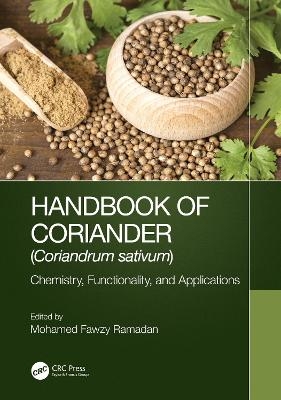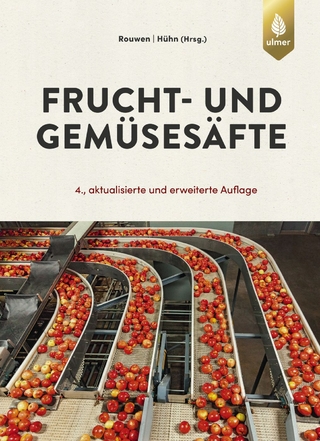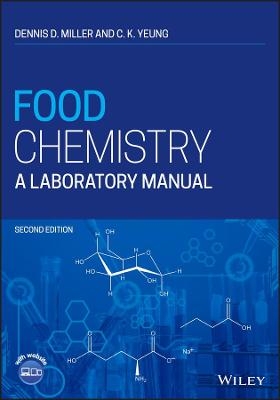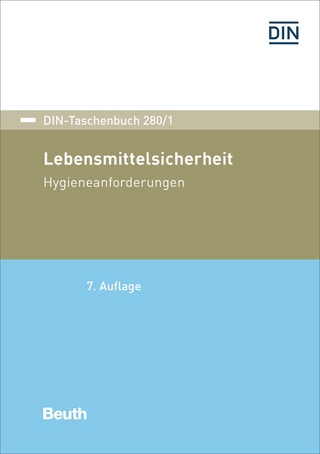
Handbook of Coriander (Coriandrum sativum)
CRC Press (Verlag)
978-1-032-06852-7 (ISBN)
Coriander (Coriandrum sativum L., family Umbelliferae/Apiaceae) is one of the most popular spices globally. Different parts of Coriandrum sativum are edible and widely used as a seasoning due to their unique flavor and aroma. Coriandrum sativum medical uses have been recognized since ancient times. Coriander leaves (cilantro) and coriander fruit (seed) are used in different ethnic foodstuffs, meat and poultry dishes, soup, pudding, bread, and seafood dishes. Coriandrum sativum is rich in linalool, vitamin A, vitamin B12, vitamin C, folate, and phenolics. Coriandrum sativum fixed oil is rich in sterols, tocols, and bioactive phytochemicals. Petroselinic acid is the major fatty acid in Coriandrum sativum fixed oil and exhibits health-promoting traits.
Coriandrum sativum is recommended as a food preservative to replace synthetic antioxidants because of its antioxidant and antibacterial traits. Furthermore, Coriandrum sativum cilantro and seeds are rich in water-soluble and lipid-soluble phytochemicals that showed unique anticancer, anxiolytic, neuroprotective, migraine-relieving, hypoglycemic, hypolipidemic, anticonvulsant, analgesic, and anti-inflammatory traits. Those medical benefits and their integration into daily life render Coriandrum sativum an excellent functional food. Regarding the cosmetic industry, Coriandrum sativum is used as an ingredient in conventional Ayurvedic cosmetic formulations to normalize skin color. In addition, Coriandrum sativum volatile oil finds use as an ingredient in perfumes.
Handbook of Coriander (Coriandrum sativum): Chemistry, Functionality, and Applications is a valuable resource for pharmaceutical and nutraceutical developers, as well as novel food developers and R&D researchers in a variety of fields that use herbs, spices, and medicinal plants.
Key Features:
Explores the chemistry of Coriandrum sativum phytochemicals, oils, and extracts
Discusses Coriandrum sativum active constituents and their health-enhancing traits
Presents the applications of Coriandrum sativum phytochemicals, oils, and extracts
Addresses the growing application areas, including horticulture, functional food, clinical nutrition, pharmaceuticals, and cosmetics
Authored by international scientists and industry experts, this book is a great resource for food chemistry, clinical nutrition, biochemistry, pharmacology, and horticulture researchers and students, as well as developers of novel food, cosmetics, and pharmaceuticals, in addition to R&D researchers in different sectors that utilize herbs, spices, and medical plants.
Mohamed Fawzy Ramadan is a Professor of Food Chemistry and a consultant of international publishing at Umm Al-Qura University, Makkah, Saudi Arabia. Since 2014, Prof. Ramadan is a Professor in the Agricultural Biochemistry Department, Faculty of Agriculture at Zagazig University, Egypt. Prof. Ramadan obtained his Ph.D. (Dr. rer. nat.) in Food Chemistry from the Berlin University of Technology (Germany, 2004). Prof. Ramadan continued his post-doctoral research at ranked universities such University of Helsinki (Finland), Max-Rubner Institute (Germany), Berlin University of Technology (Germany), and the University of Maryland (USA). In 2010, he was appointed as Visiting Professor (100% research) at King Saud University. In 2012, he was appointed as Visiting Professor (100% teaching) in the School of Biomedicine, Far Eastern Federal University in Vladivostok, Russian Federation. Prof. Ramadan published more than 300 research papers and reviews in international peer-reviewed journals. He also edited and published several books and book chapters (Scopus h-index is 43 and more than 6000 citations). In addition, he was an invited speaker at several international conferences. Since 2003, Prof. Ramadan is a reviewer and editor in several highly-cited international journals such as the Journal of Medicinal Food and Journal of Advanced Research. Prof. Ramadan received several prizes, including Abdul Hamid Shoman Prize for Arab Researcher in Agricultural Sciences (2006), Egyptian State Prize for Encouragement in Agricultural Sciences (2009), European Young Lipid Scientist Award (2009), AU-TWAS Young Scientist National Awards (Egypt) in Basic Sciences, Technology and Innovation (2012), TWAS-ARO Young Arab Scientist (YAS) Prize in Scientific and Technological Achievement (2013), and Atta-ur-Rahman Prize in Chemistry (2014).
1.Introduction to Handbook of Coriander (Coriandrum sativum): Chemistry, Functionality and Applications.
Section 1. Coriander: Cultivation, Composition and Applications
2.Coriander Cultivation and Agricultural Practices
3.Greenhouse Production of Coriander
4.Production of Coriander Using the Hydroponic Technique
5.Coriander Transcriptome: Trends, Scope, and Utilization for Coriander Improvement
6.Morphological Characters of Coriander (Coriandrum sativum L.)
7.Morphological and Physiological Characterization of Coriandrum sativum L. under Different Concentrations of Lead
8.Structural Composition of Coriander Seed
9.Phytochemicals and Secondary Metabolites of Coriander
10. Antimicrobial Activity of Coriander
11.Coriander as Antioxidant in Biological Animal Models
12.Neuroprotective Potency of Coriander
13.Pharmaceutical Applications of Coriander in Neurodegenerative Disorders
14.Pharmaceutical Applications of Coriander
15.Coriander and Physiological Systems of the Body
16.Non-Food Applications of Coriander Seeds and Leaves
17.Heavy Metals Detoxification Using Coriander
18.Coriander in Poultry Feed
19.Coriander in Fish Feed
20.Coriander Straw and Press Cake from Seeds: Compositions and Possible Uses in the Field of Bio-Sourced Materials
21.Composition and Functionality of Coriander Root
22.Coriandrum sativum L. Root Phytochemicals
23.Composition and Functionality of Agriculture Waste from Coriander Plant
Section 2. Coriander Leaves: Chemistry, Technology, Functionality and Applications
24.Bioactive Compounds of Coriander Leaves
25.A Comprehensive Review on Chemistry, Nutritional Relevance, and Potential Applications of Coriandrum sativum L. Waste/By-Products
26.Food Applications of Coriander (Coriandrum sativum) Leaves
27.Green Synthesis of Nanoparticles from Coriander Extract
28.Green Synthesis of Nanoparticles from Coriander Leaf Extract
Section 3.Coriander Fixed Oil: Chemistry, Technology, Functionality and Applications
29.Composition and Functionality of Coriander Fixed Oil
30.Effect of Processing on the Composition and Quality of Coriander Fixed Oil
31.Food Applications of Coriander Fixed Oil
32.Non-Food Applications of Coriander Fixed Oil
33.Health-Promoting Activities of Coriander Fixed Oil
Section 4. Coriander Essential Oil: Chemistry, Technology, Functionality, and Applications
34.Composition and Functionality of Coriander Essential Oil
35.Effect of Agricultural Processes and Practices on the Composition and Quality of Coriander (Coriandrum sativum L.) Essential Oil
36.Antimicrobial Activity of Coriander and Its Application in the Food Industry
37.Encapsulation of Coriander Essential Oil
38.Non-Food Applications of Coriandrum sativum Essential Oil
Section 5. Coriander Extracts: Chemistry, Technology, Functionality and Applications
39.Food Applications of Coriander Seed Extracts
40.Health-Promoting Activities of Coriander Seed Extracts
41.Coriander Extract in Biopolymer Applications
42.Non-food Applications of Coriander Seed Extracts
| Erscheinungsdatum | 27.01.2023 |
|---|---|
| Zusatzinfo | 93 Tables, black and white; 22 Line drawings, color; 51 Line drawings, black and white; 11 Halftones, color; 32 Halftones, black and white; 33 Illustrations, color; 83 Illustrations, black and white |
| Verlagsort | London |
| Sprache | englisch |
| Maße | 178 x 254 mm |
| Gewicht | 453 g |
| Themenwelt | Technik ► Lebensmitteltechnologie |
| ISBN-10 | 1-032-06852-3 / 1032068523 |
| ISBN-13 | 978-1-032-06852-7 / 9781032068527 |
| Zustand | Neuware |
| Haben Sie eine Frage zum Produkt? |
aus dem Bereich


